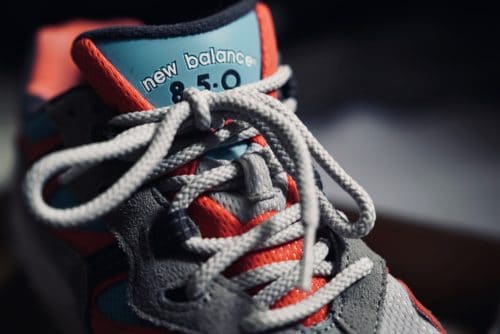This post contains affiliate links.
The tightness of my running shoes has always been a big concern to me. Today I found myself wondering if they need to be tight to be secure? Or is comfort more important?
Running shoes need to be tight enough to give your feet support. However, they must still provide your feet with enough space and flexibility for you to remain comfortable whilst exercising.
Achieving the correct tightness in your running shoe means different things for different people. Factors such as the specific shape of your foot and injuries you suffer from can also contribute to how tight your shoes should be.
How Tight Should My Running Shoes Be?
According to experts, there should always be at least a third of space in your running shoes for maximum efficiency. If your running shoes are especially stiff, then you’ll experience problems that could harm your running capability.
One example of problems with tight shoelaces could be with the so-called “pull off”. Pull off is basically the transition a runner makes when going from one foot to another. If you are making your running shoes so tight that they are becoming stiff, then you could be jeopardising your pull-off technique and, by doing so, causing a lot of damages to areas such as your calves and Achilles Tendons.
One of the most useful methods for figuring out how tight your shoes should be is by using the shoelace technique. When you tie your shoelaces, always make sure that you can fit two fingers between the eyelets.
Any more than two fingers and your shoelaces are probably too tight. Any less than two fingers and chances are the shoe is too loose. It’s all about finding the sweet spot.
Whilst the shoelace method is excellent, it’s still only a general rule. You might follow this guideline and still feel as if certain parts of your running shoe should feel tighter or looser.
Hey, if you’re like me and get frustrated with laces coming loose, why not check out these no-tie shoelaces I found on Amazon? You can adjust their length depending on the size of your shoe and they’re made of elastic which makes them extra flexible. You can check them out here!
Check out this table below that specifies exactly how much space each part of your foot should have in a running shoe.
| Area Of Foot | Correct Fit In Running Shoe |
|---|---|
| Toes | At least a thumbs width worth of space at the tip. When you run, your feet tend to swell, so it’s important to give your feet the right amount of wiggle room. |
| Mid Sole | This area should always be kept as snug as possible because it provides you with the stability and support you need whilst running. Loose material around this area could make your run feel uneasy. |
| Heel | Also as snug as possible, without being too tight. Many people experience problems with the backs of their feet when they first wear a pair of running shoes. Blisters can be a common problem if your running shoes are too slippery. |
Although these are all important things to remember when purchasing a new pair of running shoes, much of getting the right fit comes down to your own preference.
Although it’s essential to keep your running shoe snug, it’s important for your running shoes to fit in a way that you find most comfortable.

Should My Running Shoes Be Big Or Small?
By picking a slightly larger shoe, runners can accommodate for the swelling of their feet as a whole whilst still ensuring that their toes have plenty of wiggle room. The width of your running shoes can also cause issues with your foot’s overall comfort. Therefore, picking a pair of running shoes that are not only longer, but also slightly wider than the size of your foot will help your overall comfort.
When it comes to purchasing new running shoes, it’s usually a great idea to get your feet measured first. Many experts recommend picking a running shoe that is available half a size up from your standard shoe size.
There are lots of different ways you can do this, and there are plenty of websites, apps and guides out there that can help you find the ideal pair of running shoes.
However, whilst apps and quick how-to guides might give you enough information to figure out the size of shoe you want, it’s always good to get a second opinion from a professional. Experts in places such as running shops will help measure your feet by looking at the specific shape of your foot and will then be able to offer you suggestions.
If My Running Shoes Are Too Big, Can I Make Them Smaller?
If you have gone to the trouble of purchasing a larger pair of running shoes only to realise that they’re too big, you may feel uneasy about paying even more money for another pair.
Always bear in mind that if you’re running shoes feel too big whilst you are not exercising, that does not necessarily mean that they will be oversized once you’ve started running and your feet naturally swell in size.
However, if your shoes are too big, the ideal thing to do might be to suck it up and buy another pair of running shoes. In the meantime, there are a few small changes you can make to your current pair to allow them to fit as best as possible. Examples include: I
- Investing in insoles
- Wearing Thicker Tocks
- Proactively using tape on your heels to avoid any potential blisters.
Will My Running Shoes Loosen Over Time?
Whilst running shoes won’t necessarily loosen, they usually will fall victim to a lot of general wear and tear.
As you complete mile after mile, the overall material of running shoes can become worn down. Although you might only be worried about the appearance of your running shoes, it’s important to remember that, at this point, they will not give much support or allow you to give your best performance. According to Asics, running shoes should be changed anywhere between 450 to 550 miles.
What Injuries Can You Get From Tight Running Shoes?
In addition to problems with your calves and Achilles tendons, it’s important to remember that running shoes are the only equipment that runners wear that offer any kind of protection.
Therefore, if your running shoes are too tight or too loose, there is a greater chance that you will suffer from many more of the generic injuries that runners experience on a daily basis.
Examples include:
- Stress fractures
- Shin splints
- Back Pain
- Runners Knee
Conclusion
When considering how tight your running shoes should be, there are some pretty useful guidelines that you can take into consideration. By following these rules, you may become confident to trust in the tightness of your shoe.
However, much of judging the tightness of your running shoes comes down to your personal preference and finding a fit where you feel most comfortable. Just remember to watch out for injuries and take the necessary steps to protect against them!
Related Questions
Are Any Sport Shoes Designed To Be Tight?
Similarly to running shoes, other sports shoes have their own guidelines on exactly how tight they should be. For example, basketball shoes are built with lots of features in order to provide players with as much support as possible whilst playing.
Ankle injuries are very common in basketball, so players must make their laces tight enough to provide the ankle with plenty of support whilst not being so tight that the shoes cut off circulation.
On the other hand, ski boots need to be tight as possible in order to restrict any movement inside the foot, many experts even recommend picking a ski boot that is half a size too small, and it’s highly recommended that your toes are touching the tip of the boot.
What Shoes Are Best Worn Loose
There is little advantage to any particular sport wearing loose shoes. Unless it is stated explicitly that your shoes should be tight, the general consensus is that the majority of sports shoes should be exceptionally snug whilst also offering wiggle room in specific areas such as the toes. Perhaps loose-fitting shoes are best suited to be worn during leisure. Take slippers, for example!

